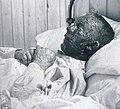| 1896 Gloucester smallpox epidemic | |
|---|---|
 Henry Wicklin, age 6, afflicted with smallpox
[1] | |
| Disease | Smallpox |
| Location | Gloucester, UK |
| Confirmed cases | Over 2,000 [2] |

The 1896 Gloucester smallpox epidemic affected more than 2,000 people in Gloucester between 5 January and 27 July 1896. A large number of the town's population were not vaccinated. [3]
On 13 August 1896, the Royal Commission on Vaccination's report on the epidemic was published by the Royal College of Surgeons of England.
Background
In Britain, smallpox vaccination became compulsory in the 1850s. [4] In Gloucester, a smallpox outbreak occurred in the mid-1870s. [5] [6] However, the 1890s also saw anti-vaccination beliefs. [7] [8]
Cases
President of the Local Government Board Thomas Russell stated in 1896 that, between 4 January and 25 July 1896, the number of cases of smallpox in Gloucester totalled 2,008. [2] A large number of the town's population were not vaccinated. [9]
Ethel Cromwell
Ethel Cromwell was around 14 years old when her photograph was taken in a hospital in Gloucester, following admission with smallpox. She was not vaccinated, but recovered. [4]
-
Ethel Cromwell (with smallpox) [4]
-
Ethel Cromwell (convalescing) [4]
-
Ephraim Beard with smallpox. Died on 13 April 1896
Response
An isolation hospital, the Stroud Road hospital was built in response. [10]
One reaction was that it led to prejudice against Gloucesterians. [11]
On 13 August 1896, the Royal College of Surgeons of England published a report by the Royal Commission on Vaccination, whose members included Lord Herschell and Sir James Paget. [7]
A subsequent outbreak of smallpox occurred in 1923. [10]
See also
References
- ^ "Gloucester smallpox epidemic, 1896: Henry Wicklin, aged 6 years, as a smallpox patient. Photograph by H.C.F., 1896". Wellcome Collection. Retrieved 4 May 2020.
- ^ a b "Smallpox Epidemic (Gloucester) (Hansard, 13 August 1896)". api.parliament.uk. Retrieved 6 May 2020.
- ^ Lillywhite, Maisie (28 February 2021). "Epidemic that gripped Victorian Gloucester 125 years before Covid". GloucestershireLive. Retrieved 10 May 2022.
- ^ a b c d "The child whose town rejected vaccines". Wellcome Collection. Retrieved 3 May 2020.
- ^ Rolleston, J. D. (December 1933). "The Smallpox Pandemic of 1870-1874". Proceedings of the Royal Society of Medicine. 27 (2): 177–192. doi: 10.1177/003591573302700245. ISSN 0035-9157. PMC 2204618. PMID 19989604.
- ^ Richardson, Harriet. "Architecture of Isolation". Society of Architectural Historians of Great Britain. Retrieved 10 May 2022.
- ^ a b Kotar, S. L.; Gessler, J. E. (2013). Smallpox: A History. McFarland. p. 259. ISBN 978-0-7864-9327-2.
- ^ Durbach, Nadja (2005). Bodily Matters: The Anti-Vaccination Movement in England, 1853–1907. Duke University Press. p. 177. ISBN 0-8223-3423-2.
- ^ "The Gloucester Small-pox Epidemic". British Medical Journal. 1 (1941): 703–704. 12 March 1898. doi: 10.1136/bmj.1.1941.703. ISSN 0007-1447. PMC 2410935. PMID 20757701.
- ^ a b "Gloucester: Hospitals". British History Online. Retrieved 8 May 2020.
- ^ Williams, Dick. "April 2020: Rugby is disrupted at Kingsholm". Gloucester Rugby Heritage. Retrieved 3 May 2020.
Further reading
- The smallpox epidemic in Gloucester in 1895-6, and the water cure. Pickering, J. (1896)
- Gloucester epidemic of small-pox, 1895-6 : report of the committee appointed by the Board of Guardians to organise and carry out the general vaccination of the city and district. Gloucester (England) Royal College of Surgeons of England (1896)
- What the press has said about the Gloucester epidemic and the report of the Royal Commission on Vaccination Royal College of Surgeons of England (1896)
- Does vaccination prevent smallpox? Does vaccination prevent smallpox? : a lesson taught from the Gloucester epidemic. Drysdale, Charles R., London Vegetarian Society (1896)
- Smallpox at Gloucester: A Reply to Dr. Coupland's Report, 1902. Reprinted from "The Reformer," National Anti-Vaccination League: Gloucester.
External links
-
 Media related to
1896 Gloucester smallpox epidemic at Wikimedia Commons
Media related to
1896 Gloucester smallpox epidemic at Wikimedia Commons
![Ethel Cromwell (with smallpox)[4]](https://upload.wikimedia.org/wikipedia/commons/thumb/8/85/Gloucester_smallpox_epidemic%2C_1896%3B_Ethel_Cromwell_Wellcome_V0031460.jpg/89px-Gloucester_smallpox_epidemic%2C_1896%3B_Ethel_Cromwell_Wellcome_V0031460.jpg)
![Ethel Cromwell (convalescing)[4]](https://upload.wikimedia.org/wikipedia/commons/thumb/f/f8/Gloucester_smallpox_epidemic%2C_1896%3B_Ethel_Cromwell_Wellcome_V0031461.jpg/90px-Gloucester_smallpox_epidemic%2C_1896%3B_Ethel_Cromwell_Wellcome_V0031461.jpg)
